Corporate Accounting Assignment: Theory and Application
VerifiedAdded on 2023/04/24
|9
|1639
|428
Homework Assignment
AI Summary
This assignment solution addresses corporate accounting principles, specifically focusing on impairment of assets and their disposal. Part A presents a 1000-word essay explaining recoverable amounts, value in use, and the process of asset disposal according to International Accounting Standard 36. It covers the calculation of recoverable amounts, the significance of impairment loss, and the conditions under which an entity should recognize and reverse an impairment loss, including the concept of Cash Generating Units (CGUs). Part B provides a practical application of the theory, including journal entries for Gali Limited, detailing the impairment loss allocation across various asset accounts, calculations of impairment loss, and the apportionment of the loss. The solution includes workings demonstrating how the impairment loss is calculated based on the carrying amount and the value in use of the division. The assignment is thoroughly referenced, citing various accounting standards and academic sources.
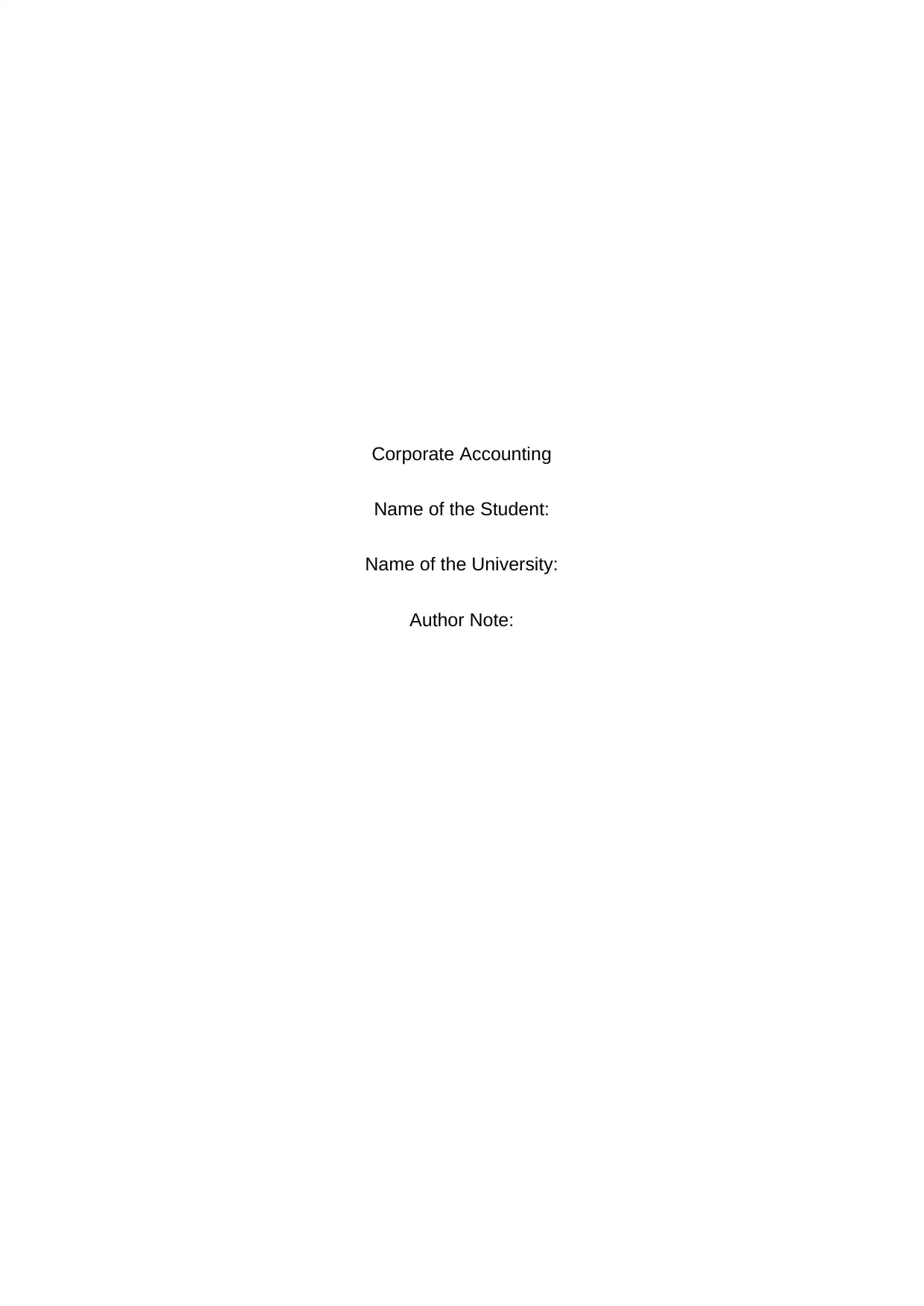
Corporate Accounting
Name of the Student:
Name of the University:
Author Note:
Name of the Student:
Name of the University:
Author Note:
Paraphrase This Document
Need a fresh take? Get an instant paraphrase of this document with our AI Paraphraser
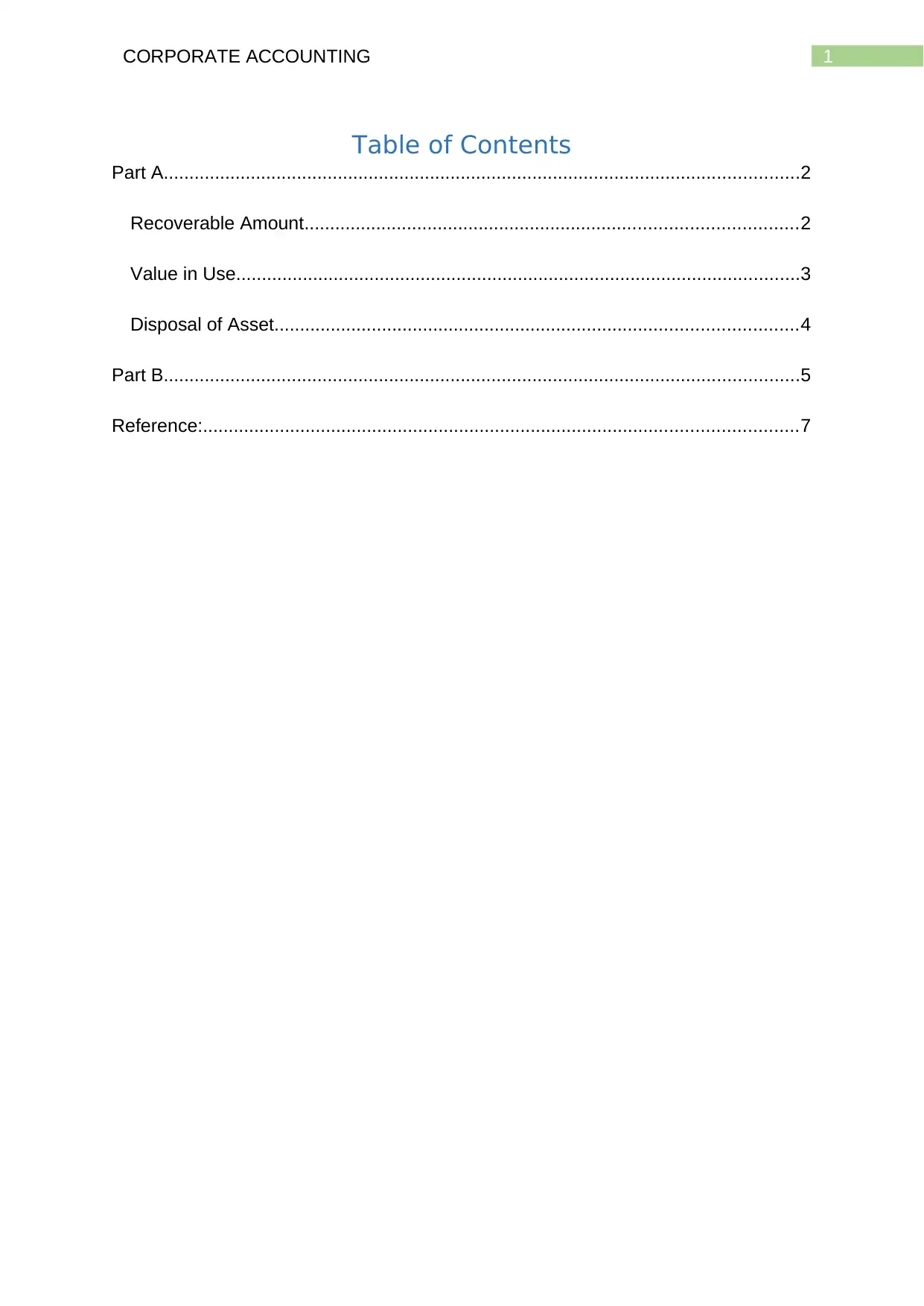
1CORPORATE ACCOUNTING
Table of Contents
Part A............................................................................................................................2
Recoverable Amount................................................................................................2
Value in Use..............................................................................................................3
Disposal of Asset......................................................................................................4
Part B............................................................................................................................5
Reference:....................................................................................................................7
Table of Contents
Part A............................................................................................................................2
Recoverable Amount................................................................................................2
Value in Use..............................................................................................................3
Disposal of Asset......................................................................................................4
Part B............................................................................................................................5
Reference:....................................................................................................................7
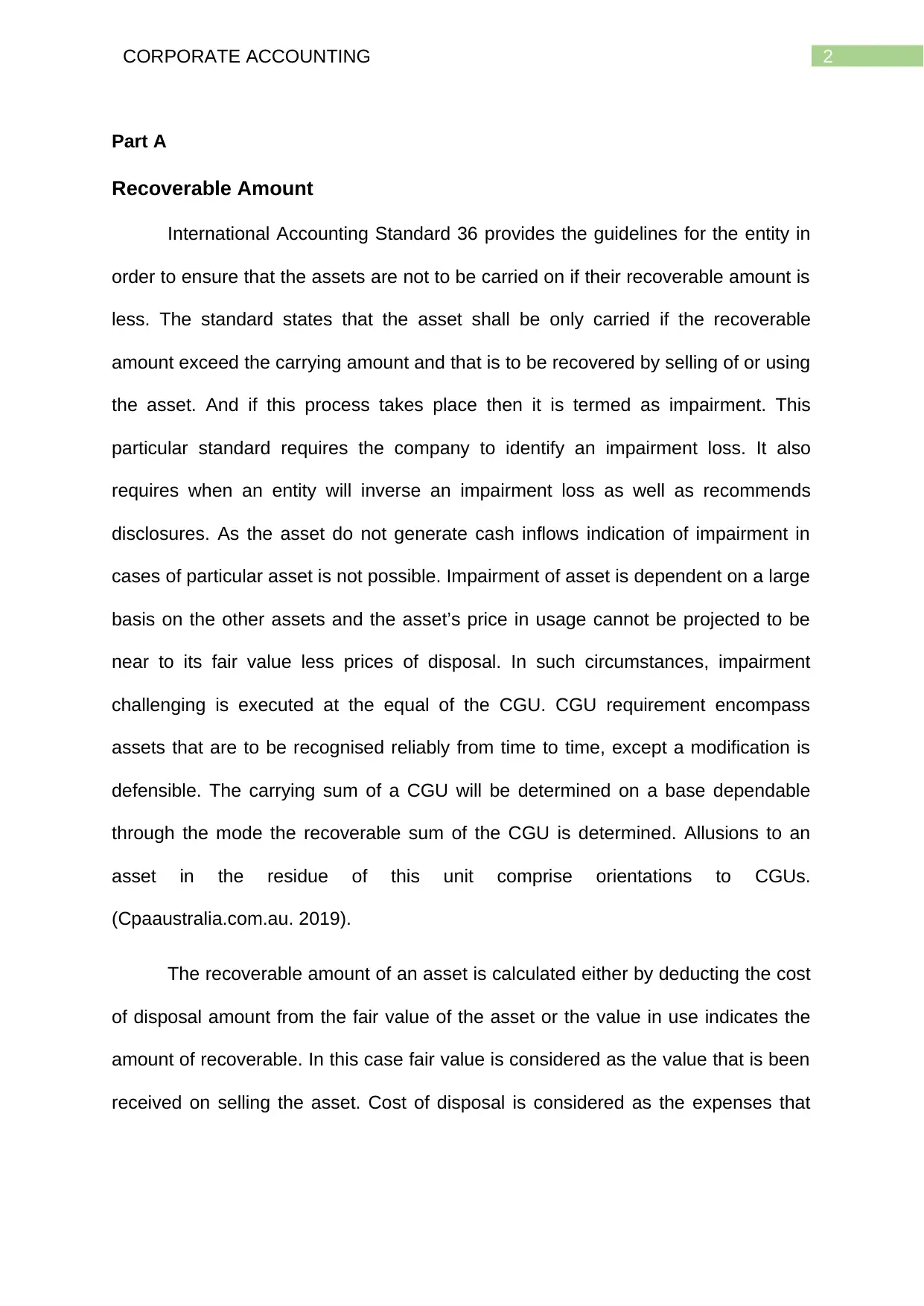
2CORPORATE ACCOUNTING
Part A
Recoverable Amount
International Accounting Standard 36 provides the guidelines for the entity in
order to ensure that the assets are not to be carried on if their recoverable amount is
less. The standard states that the asset shall be only carried if the recoverable
amount exceed the carrying amount and that is to be recovered by selling of or using
the asset. And if this process takes place then it is termed as impairment. This
particular standard requires the company to identify an impairment loss. It also
requires when an entity will inverse an impairment loss as well as recommends
disclosures. As the asset do not generate cash inflows indication of impairment in
cases of particular asset is not possible. Impairment of asset is dependent on a large
basis on the other assets and the asset’s price in usage cannot be projected to be
near to its fair value less prices of disposal. In such circumstances, impairment
challenging is executed at the equal of the CGU. CGU requirement encompass
assets that are to be recognised reliably from time to time, except a modification is
defensible. The carrying sum of a CGU will be determined on a base dependable
through the mode the recoverable sum of the CGU is determined. Allusions to an
asset in the residue of this unit comprise orientations to CGUs.
(Cpaaustralia.com.au. 2019).
The recoverable amount of an asset is calculated either by deducting the cost
of disposal amount from the fair value of the asset or the value in use indicates the
amount of recoverable. In this case fair value is considered as the value that is been
received on selling the asset. Cost of disposal is considered as the expenses that
Part A
Recoverable Amount
International Accounting Standard 36 provides the guidelines for the entity in
order to ensure that the assets are not to be carried on if their recoverable amount is
less. The standard states that the asset shall be only carried if the recoverable
amount exceed the carrying amount and that is to be recovered by selling of or using
the asset. And if this process takes place then it is termed as impairment. This
particular standard requires the company to identify an impairment loss. It also
requires when an entity will inverse an impairment loss as well as recommends
disclosures. As the asset do not generate cash inflows indication of impairment in
cases of particular asset is not possible. Impairment of asset is dependent on a large
basis on the other assets and the asset’s price in usage cannot be projected to be
near to its fair value less prices of disposal. In such circumstances, impairment
challenging is executed at the equal of the CGU. CGU requirement encompass
assets that are to be recognised reliably from time to time, except a modification is
defensible. The carrying sum of a CGU will be determined on a base dependable
through the mode the recoverable sum of the CGU is determined. Allusions to an
asset in the residue of this unit comprise orientations to CGUs.
(Cpaaustralia.com.au. 2019).
The recoverable amount of an asset is calculated either by deducting the cost
of disposal amount from the fair value of the asset or the value in use indicates the
amount of recoverable. In this case fair value is considered as the value that is been
received on selling the asset. Cost of disposal is considered as the expenses that
⊘ This is a preview!⊘
Do you want full access?
Subscribe today to unlock all pages.

Trusted by 1+ million students worldwide
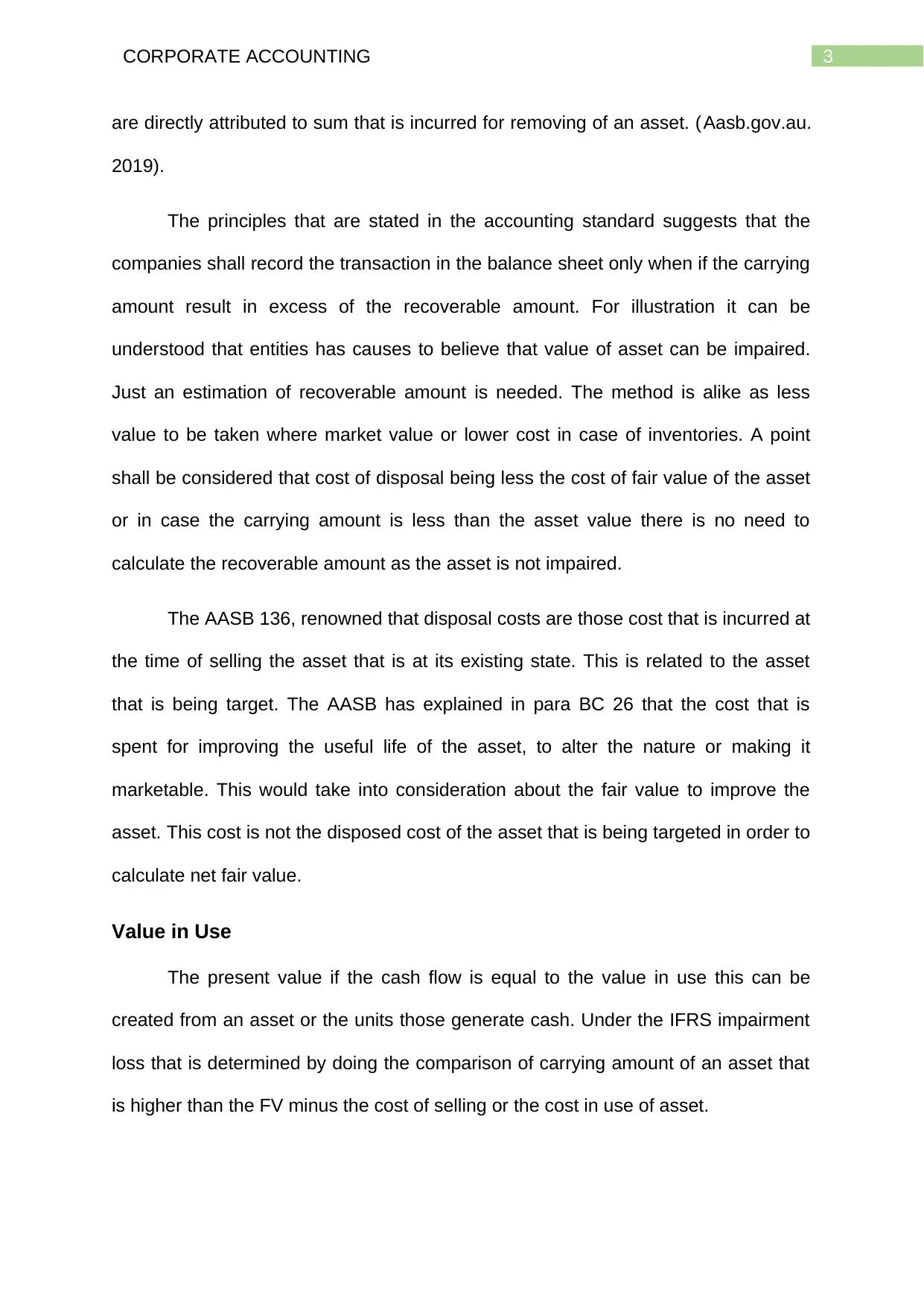
3CORPORATE ACCOUNTING
are directly attributed to sum that is incurred for removing of an asset. (Aasb.gov.au.
2019).
The principles that are stated in the accounting standard suggests that the
companies shall record the transaction in the balance sheet only when if the carrying
amount result in excess of the recoverable amount. For illustration it can be
understood that entities has causes to believe that value of asset can be impaired.
Just an estimation of recoverable amount is needed. The method is alike as less
value to be taken where market value or lower cost in case of inventories. A point
shall be considered that cost of disposal being less the cost of fair value of the asset
or in case the carrying amount is less than the asset value there is no need to
calculate the recoverable amount as the asset is not impaired.
The AASB 136, renowned that disposal costs are those cost that is incurred at
the time of selling the asset that is at its existing state. This is related to the asset
that is being target. The AASB has explained in para BC 26 that the cost that is
spent for improving the useful life of the asset, to alter the nature or making it
marketable. This would take into consideration about the fair value to improve the
asset. This cost is not the disposed cost of the asset that is being targeted in order to
calculate net fair value.
Value in Use
The present value if the cash flow is equal to the value in use this can be
created from an asset or the units those generate cash. Under the IFRS impairment
loss that is determined by doing the comparison of carrying amount of an asset that
is higher than the FV minus the cost of selling or the cost in use of asset.
are directly attributed to sum that is incurred for removing of an asset. (Aasb.gov.au.
2019).
The principles that are stated in the accounting standard suggests that the
companies shall record the transaction in the balance sheet only when if the carrying
amount result in excess of the recoverable amount. For illustration it can be
understood that entities has causes to believe that value of asset can be impaired.
Just an estimation of recoverable amount is needed. The method is alike as less
value to be taken where market value or lower cost in case of inventories. A point
shall be considered that cost of disposal being less the cost of fair value of the asset
or in case the carrying amount is less than the asset value there is no need to
calculate the recoverable amount as the asset is not impaired.
The AASB 136, renowned that disposal costs are those cost that is incurred at
the time of selling the asset that is at its existing state. This is related to the asset
that is being target. The AASB has explained in para BC 26 that the cost that is
spent for improving the useful life of the asset, to alter the nature or making it
marketable. This would take into consideration about the fair value to improve the
asset. This cost is not the disposed cost of the asset that is being targeted in order to
calculate net fair value.
Value in Use
The present value if the cash flow is equal to the value in use this can be
created from an asset or the units those generate cash. Under the IFRS impairment
loss that is determined by doing the comparison of carrying amount of an asset that
is higher than the FV minus the cost of selling or the cost in use of asset.
Paraphrase This Document
Need a fresh take? Get an instant paraphrase of this document with our AI Paraphraser
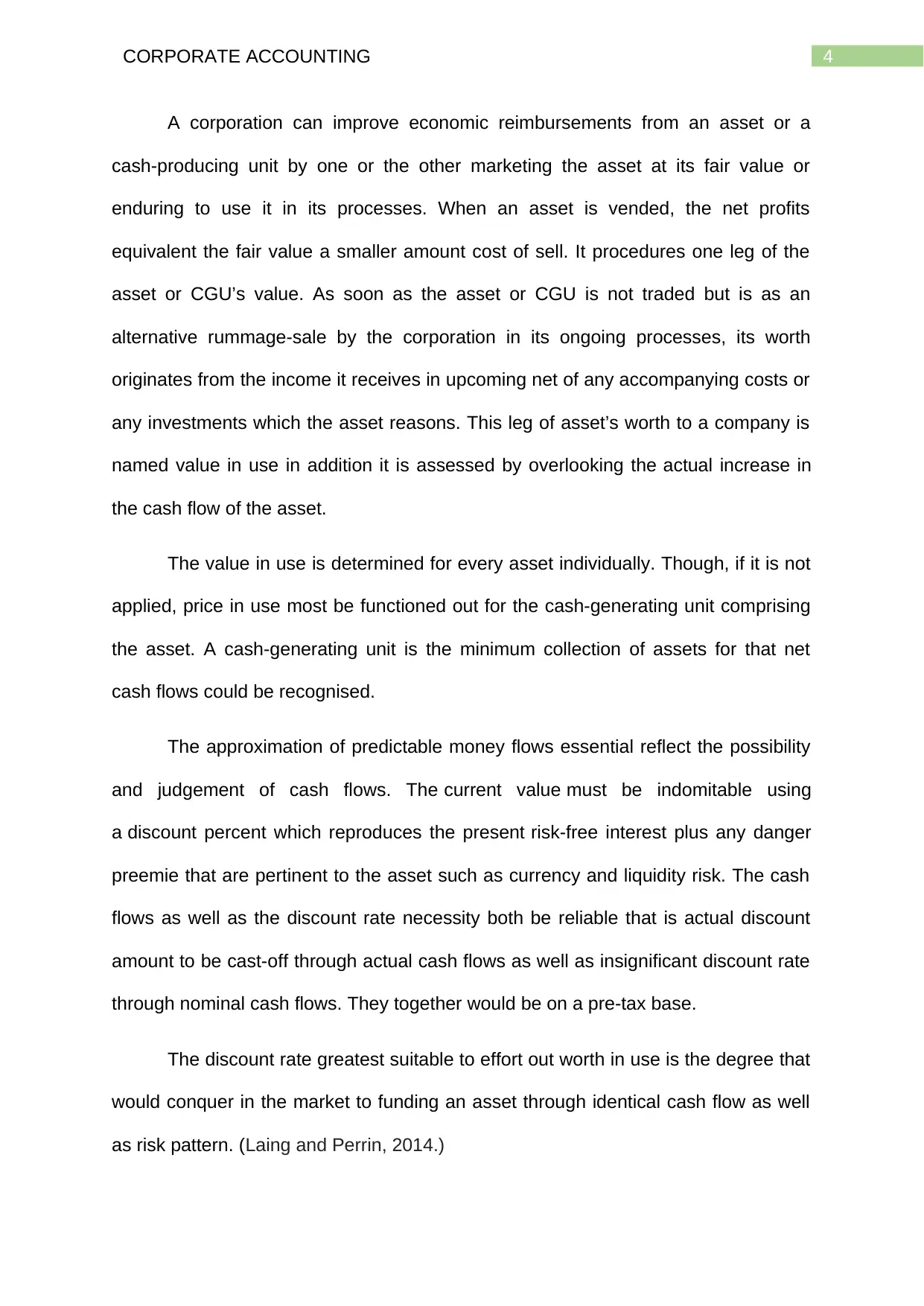
4CORPORATE ACCOUNTING
A corporation can improve economic reimbursements from an asset or a
cash-producing unit by one or the other marketing the asset at its fair value or
enduring to use it in its processes. When an asset is vended, the net profits
equivalent the fair value a smaller amount cost of sell. It procedures one leg of the
asset or CGU’s value. As soon as the asset or CGU is not traded but is as an
alternative rummage-sale by the corporation in its ongoing processes, its worth
originates from the income it receives in upcoming net of any accompanying costs or
any investments which the asset reasons. This leg of asset’s worth to a company is
named value in use in addition it is assessed by overlooking the actual increase in
the cash flow of the asset.
The value in use is determined for every asset individually. Though, if it is not
applied, price in use most be functioned out for the cash-generating unit comprising
the asset. A cash-generating unit is the minimum collection of assets for that net
cash flows could be recognised.
The approximation of predictable money flows essential reflect the possibility
and judgement of cash flows. The current value must be indomitable using
a discount percent which reproduces the present risk-free interest plus any danger
preemie that are pertinent to the asset such as currency and liquidity risk. The cash
flows as well as the discount rate necessity both be reliable that is actual discount
amount to be cast-off through actual cash flows as well as insignificant discount rate
through nominal cash flows. They together would be on a pre-tax base.
The discount rate greatest suitable to effort out worth in use is the degree that
would conquer in the market to funding an asset through identical cash flow as well
as risk pattern. (Laing and Perrin, 2014.)
A corporation can improve economic reimbursements from an asset or a
cash-producing unit by one or the other marketing the asset at its fair value or
enduring to use it in its processes. When an asset is vended, the net profits
equivalent the fair value a smaller amount cost of sell. It procedures one leg of the
asset or CGU’s value. As soon as the asset or CGU is not traded but is as an
alternative rummage-sale by the corporation in its ongoing processes, its worth
originates from the income it receives in upcoming net of any accompanying costs or
any investments which the asset reasons. This leg of asset’s worth to a company is
named value in use in addition it is assessed by overlooking the actual increase in
the cash flow of the asset.
The value in use is determined for every asset individually. Though, if it is not
applied, price in use most be functioned out for the cash-generating unit comprising
the asset. A cash-generating unit is the minimum collection of assets for that net
cash flows could be recognised.
The approximation of predictable money flows essential reflect the possibility
and judgement of cash flows. The current value must be indomitable using
a discount percent which reproduces the present risk-free interest plus any danger
preemie that are pertinent to the asset such as currency and liquidity risk. The cash
flows as well as the discount rate necessity both be reliable that is actual discount
amount to be cast-off through actual cash flows as well as insignificant discount rate
through nominal cash flows. They together would be on a pre-tax base.
The discount rate greatest suitable to effort out worth in use is the degree that
would conquer in the market to funding an asset through identical cash flow as well
as risk pattern. (Laing and Perrin, 2014.)
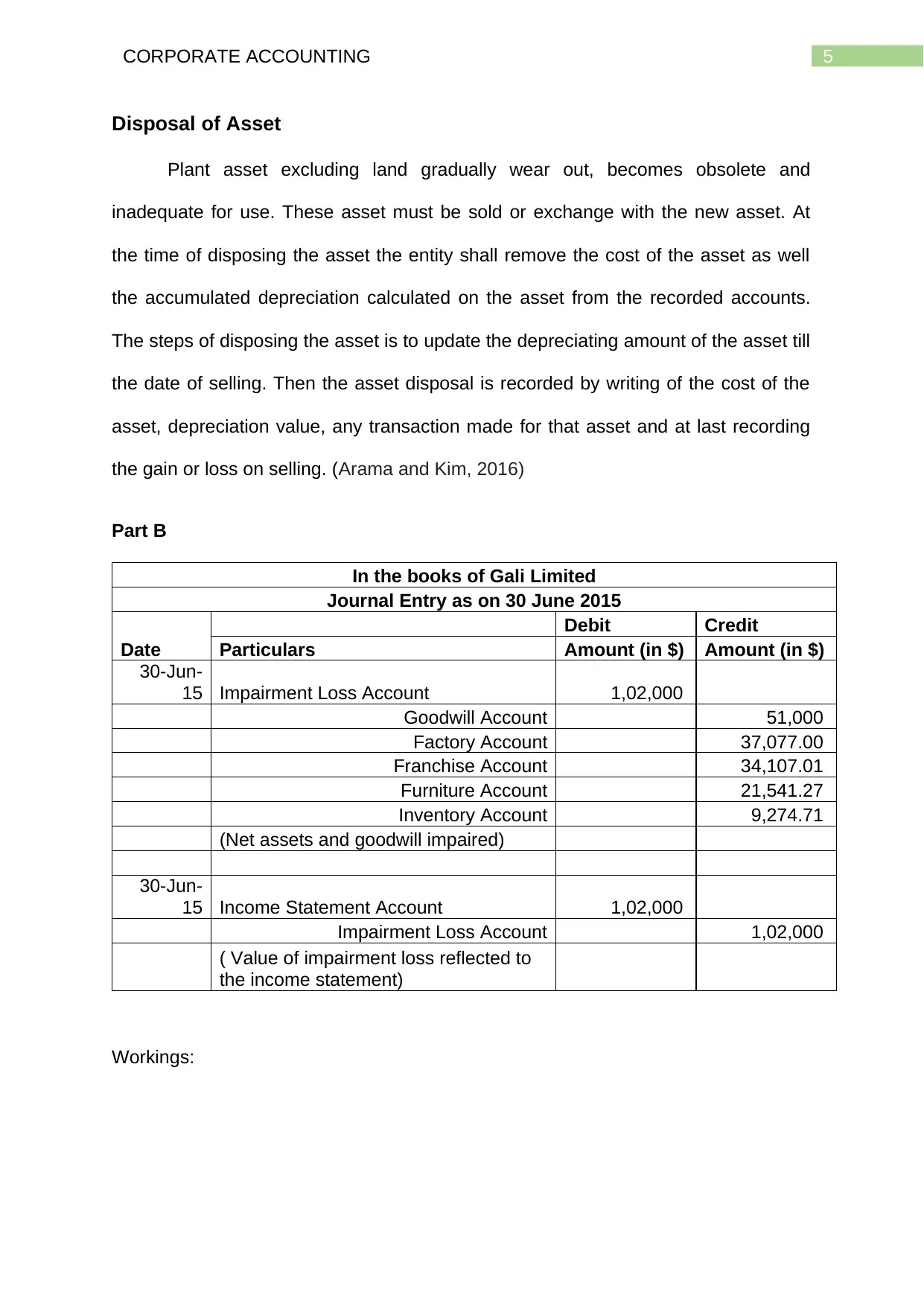
5CORPORATE ACCOUNTING
Disposal of Asset
Plant asset excluding land gradually wear out, becomes obsolete and
inadequate for use. These asset must be sold or exchange with the new asset. At
the time of disposing the asset the entity shall remove the cost of the asset as well
the accumulated depreciation calculated on the asset from the recorded accounts.
The steps of disposing the asset is to update the depreciating amount of the asset till
the date of selling. Then the asset disposal is recorded by writing of the cost of the
asset, depreciation value, any transaction made for that asset and at last recording
the gain or loss on selling. (Arama and Kim, 2016)
Part B
In the books of Gali Limited
Journal Entry as on 30 June 2015
Date
Debit Credit
Particulars Amount (in $) Amount (in $)
30-Jun-
15 Impairment Loss Account 1,02,000
Goodwill Account 51,000
Factory Account 37,077.00
Franchise Account 34,107.01
Furniture Account 21,541.27
Inventory Account 9,274.71
(Net assets and goodwill impaired)
30-Jun-
15 Income Statement Account 1,02,000
Impairment Loss Account 1,02,000
( Value of impairment loss reflected to
the income statement)
Workings:
Disposal of Asset
Plant asset excluding land gradually wear out, becomes obsolete and
inadequate for use. These asset must be sold or exchange with the new asset. At
the time of disposing the asset the entity shall remove the cost of the asset as well
the accumulated depreciation calculated on the asset from the recorded accounts.
The steps of disposing the asset is to update the depreciating amount of the asset till
the date of selling. Then the asset disposal is recorded by writing of the cost of the
asset, depreciation value, any transaction made for that asset and at last recording
the gain or loss on selling. (Arama and Kim, 2016)
Part B
In the books of Gali Limited
Journal Entry as on 30 June 2015
Date
Debit Credit
Particulars Amount (in $) Amount (in $)
30-Jun-
15 Impairment Loss Account 1,02,000
Goodwill Account 51,000
Factory Account 37,077.00
Franchise Account 34,107.01
Furniture Account 21,541.27
Inventory Account 9,274.71
(Net assets and goodwill impaired)
30-Jun-
15 Income Statement Account 1,02,000
Impairment Loss Account 1,02,000
( Value of impairment loss reflected to
the income statement)
Workings:
⊘ This is a preview!⊘
Do you want full access?
Subscribe today to unlock all pages.

Trusted by 1+ million students worldwide
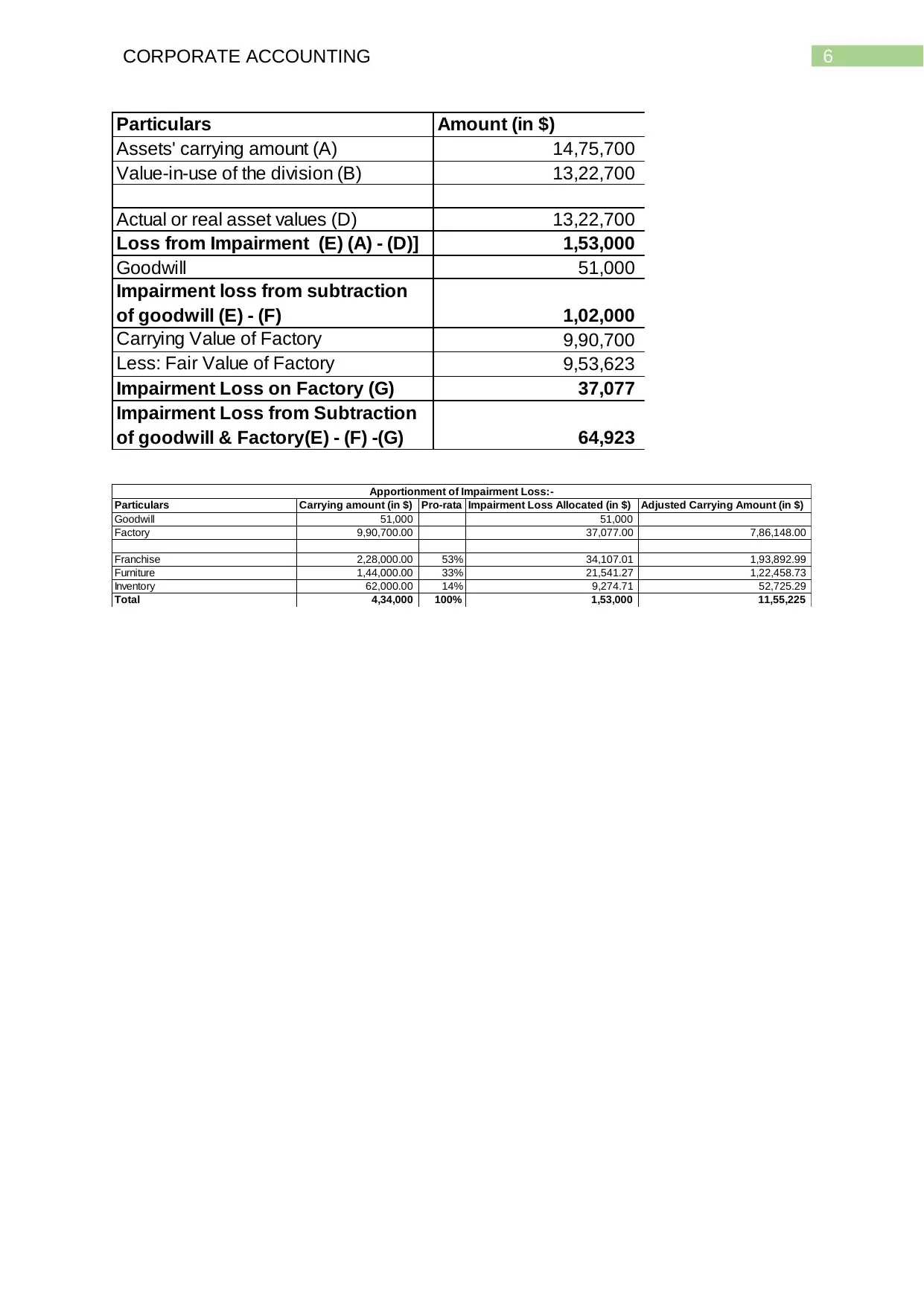
6CORPORATE ACCOUNTING
Particulars Amount (in $)
Assets' carrying amount (A) 14,75,700
Value-in-use of the division (B) 13,22,700
Actual or real asset values (D) 13,22,700
Loss from Impairment (E) (A) - (D)] 1,53,000
Goodwill 51,000
Impairment loss from subtraction
of goodwill (E) - (F) 1,02,000
Carrying Value of Factory 9,90,700
Less: Fair Value of Factory 9,53,623
Impairment Loss on Factory (G) 37,077
Impairment Loss from Subtraction
of goodwill & Factory(E) - (F) -(G) 64,923
Particulars Carrying amount (in $) Pro-rata Impairment Loss Allocated (in $) Adjusted Carrying Amount (in $)
Goodwill 51,000 51,000
Factory 9,90,700.00 37,077.00 7,86,148.00
Franchise 2,28,000.00 53% 34,107.01 1,93,892.99
Furniture 1,44,000.00 33% 21,541.27 1,22,458.73
Inventory 62,000.00 14% 9,274.71 52,725.29
Total 4,34,000 100% 1,53,000 11,55,225
Apportionment of Impairment Loss:-
Particulars Amount (in $)
Assets' carrying amount (A) 14,75,700
Value-in-use of the division (B) 13,22,700
Actual or real asset values (D) 13,22,700
Loss from Impairment (E) (A) - (D)] 1,53,000
Goodwill 51,000
Impairment loss from subtraction
of goodwill (E) - (F) 1,02,000
Carrying Value of Factory 9,90,700
Less: Fair Value of Factory 9,53,623
Impairment Loss on Factory (G) 37,077
Impairment Loss from Subtraction
of goodwill & Factory(E) - (F) -(G) 64,923
Particulars Carrying amount (in $) Pro-rata Impairment Loss Allocated (in $) Adjusted Carrying Amount (in $)
Goodwill 51,000 51,000
Factory 9,90,700.00 37,077.00 7,86,148.00
Franchise 2,28,000.00 53% 34,107.01 1,93,892.99
Furniture 1,44,000.00 33% 21,541.27 1,22,458.73
Inventory 62,000.00 14% 9,274.71 52,725.29
Total 4,34,000 100% 1,53,000 11,55,225
Apportionment of Impairment Loss:-
Paraphrase This Document
Need a fresh take? Get an instant paraphrase of this document with our AI Paraphraser

7CORPORATE ACCOUNTING
Reference:
Aasb.gov.au. (2019). [online] Available at:
https://www.aasb.gov.au/admin/file/content102/c3/AAS04_8-97.pdf [Accessed 24
Jan. 2019].
Amiraslani, H., Iatridis, G.E. and Pope, P.F., 2013. Accounting for asset impairment:
a test for IFRS compliance across Europe. Centre for Financial Analysis and
Reporting Research (CeFARR).
Arama, M.G. and Kim, L., 2016. Using waste hierarchy concept for optimizing the
management of the waste disposal amount and implicitly of the possible ecological
risk.
Camodeca, R., Almici, A. and Bernardi, M., 2013. Goodwill impairment testing under
IFRS before and after the financial crisis: evidence from the UK large listed
companies. Problems and perspectives in management, 11(3), pp.17-23.
Cpaaustralia.com.au. (2019). [online] Available at:
https://www.cpaaustralia.com.au/~/media/corporate/allfiles/document/professional-
resources/reporting/reporting-ifrsfactsheet-impairment-of-assets.pdf?la=en
[Accessed 24 Jan. 2019].
Laing, G. and Perrin, R.W., 2014. Deconstructing an accounting paradigm shift:
AASB 116 non-current asset measurement models. International Journal of Critical
Accounting, 6(5/6), pp.509-519.
Nomura, K. and Suga, Y., 2013, October. Asset service lives and depreciation rates
based on disposal data in Japan. In Economic Measurement Group Workshop
Asia (pp. 15-16).
Reference:
Aasb.gov.au. (2019). [online] Available at:
https://www.aasb.gov.au/admin/file/content102/c3/AAS04_8-97.pdf [Accessed 24
Jan. 2019].
Amiraslani, H., Iatridis, G.E. and Pope, P.F., 2013. Accounting for asset impairment:
a test for IFRS compliance across Europe. Centre for Financial Analysis and
Reporting Research (CeFARR).
Arama, M.G. and Kim, L., 2016. Using waste hierarchy concept for optimizing the
management of the waste disposal amount and implicitly of the possible ecological
risk.
Camodeca, R., Almici, A. and Bernardi, M., 2013. Goodwill impairment testing under
IFRS before and after the financial crisis: evidence from the UK large listed
companies. Problems and perspectives in management, 11(3), pp.17-23.
Cpaaustralia.com.au. (2019). [online] Available at:
https://www.cpaaustralia.com.au/~/media/corporate/allfiles/document/professional-
resources/reporting/reporting-ifrsfactsheet-impairment-of-assets.pdf?la=en
[Accessed 24 Jan. 2019].
Laing, G. and Perrin, R.W., 2014. Deconstructing an accounting paradigm shift:
AASB 116 non-current asset measurement models. International Journal of Critical
Accounting, 6(5/6), pp.509-519.
Nomura, K. and Suga, Y., 2013, October. Asset service lives and depreciation rates
based on disposal data in Japan. In Economic Measurement Group Workshop
Asia (pp. 15-16).

8CORPORATE ACCOUNTING
⊘ This is a preview!⊘
Do you want full access?
Subscribe today to unlock all pages.

Trusted by 1+ million students worldwide
1 out of 9
Related Documents
Your All-in-One AI-Powered Toolkit for Academic Success.
+13062052269
info@desklib.com
Available 24*7 on WhatsApp / Email
![[object Object]](/_next/static/media/star-bottom.7253800d.svg)
Unlock your academic potential
Copyright © 2020–2025 A2Z Services. All Rights Reserved. Developed and managed by ZUCOL.





